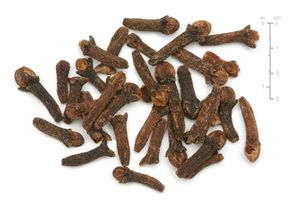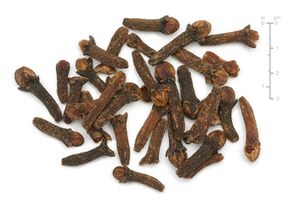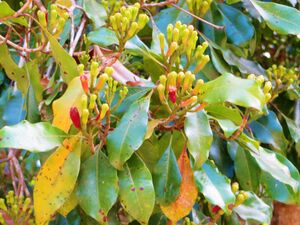قرنفل
| قرنفل Clove | |
|---|---|

| |
| التصنيف العلمي | |
| مملكة: | |
| Division: | |
| Class: | |
| Order: | |
| Family: | |
| Genus: | |
| Species: | S. aromaticum
|
| Binomial name | |
| Syzygium aromaticum | |
| Synonyms[1] | |
| |
القرنفل Clove (الاسم العلمي: Eugina aromatica) هو نبات شجري دائم الخضرة ، أوراقه ذات نكهة ، وأزهاره وردية اللون. ويحصل عليه من جزر ملقا و بمبا و موريشيوس و البرازيل و جنوب الفلبين. وتجمع براعمه فيما بين تفتح الأزهار. وقد جلب القرنفل إلى أوروبا فيما بين القرنين الرابع والسادس. وكان في الصين القديمة تقليد ريفي بأن يضع الأشخاص المخلصون في أفواههم حبة قرنفل حتى يخرج الحديث نقيا. وقد صنع الإليزابثيون ما أسموه بالكرات العطرية، وهي عبارة عن حبات من البرتقال رشقت فيها حبات القرنفل، وكانوا يعلقونها في خزانات الثياب.
الوصف
The clove tree is an evergreen that grows up to 8–12 metres (26–39 ft) tall, with large leaves and crimson flowers grouped in terminal clusters. The flower buds initially have a pale hue, gradually turn green, then transition to a bright red when ready for harvest. Cloves are harvested at 1.5–2 centimetres (5⁄8–3⁄4 in) long, and consist of a long calyx that terminates in four spreading sepals, and four unopened petals that form a small central ball.
Clove stalks are slender stems of the inflorescence axis that show opposite decussate branching. Externally, they are brownish, rough, and irregularly wrinkled longitudinally with short fracture and dry, woody texture. Mother cloves (anthophylli) are the ripe fruits of cloves that are ovoid, brown berries, unilocular and one-seeded. Blown cloves are expanded flowers from which both corollae and stamens have been detached. Exhausted cloves have most or all the oil removed by distillation. They yield no oil and are darker in color.[بحاجة لمصدر]
القسم المستخدم
براعم الزهور الناضجة المجففة
مكوناته
يتألف من 15-20% زيت عطري مؤلف بشكل أساسي من الأوجينول Eugenol، ومواد دباغية، وأحماض زيتية, وكاريوفيللين.
استعماله
Cloves are used in the cuisine of Asian, African, Mediterranean, and the Near and Middle East countries, lending flavor to meats (such as baked ham), curries, and marinades, as well as fruit (such as apples, pears, and rhubarb). Cloves may be used to give aromatic and flavor qualities to hot beverages, often combined with other ingredients such as lemon and sugar. They are a common element in spice blends, including pumpkin pie spice and speculaas spices.
In Mexican cuisine, cloves are best known as clavos de olor, and often accompany cumin and cinnamon.[2] They are also used in Peruvian cuisine, in a wide variety of dishes such as carapulcra and arroz con leche.
A major component of clove taste is imparted by the chemical eugenol,[3] and the quantity of the spice required is typically small. It pairs well with cinnamon, allspice, vanilla, red wine, basil, onion, citrus peel, star anise, and peppercorns.
استخدامات غير الطهي
The spice is used in a type of cigarette called kretek in Indonesia.[1] Clove cigarettes were smoked throughout Europe, Asia, and the United States. Clove cigarettes are currently classified in the United States as cigars,[4] the result of a ban of flavored cigarettes in September 2009.[5]
Clove essential oil may be used to inhibit mold growth on various types of foods.[6] In addition to these non-culinary uses of clove, it can be used to protect wood in a system for cultural heritage conservation, and showed the efficacy of clove essential oil to be higher than a boron-based wood preservative.[7] Cloves can be used to make a fragrant pomander when combined with an orange. When given as a gift in Victorian England, such a pomander indicated warmth of feeling.
استخدامات طبية محتملة وأعراض جانبية
مطهر ومخدر للأسنان ويستخدم زيته مع أكسيد الزنك لعمل معجون مسكن.
يفيد في آلام الرأس ويحمي من الأوبئة حيث أنه مضاد للفطريات والميكروبات ويزيد من فعالية العقار المضاد للفيروسات.
منبه للقلب والمعدة.
خافض للحرارة.
مقوي للتقلصات الرحمية عند الولادة.
مخفف للحموضة, ومفيد في حالات سوء الهضم والغازات الناتجة عن التهاب المعدة حيث يثبط الأوجينول انتقال الإشارات العصبية التي تؤدي لشعور الشخص بالانتفاخ.[8]
محاذير الاستخدام
يمنع عن الحوامل قبل فترة المخاض. الإكثار منه قد يسبب اضطرابات عصبية ويرفع ضغط الدم. قد يصيب الأطفال دون السادسة باضطراب في المعدة أو بحالة تهيج. يجي تجنب استخدامه بكثرة وخاصة للمصابين باضطرابات في وظائف الكبد لأنه قد يسبب تسمماً فيه. إذا ترك لفترة طويلة على السن المتهيج فإنه قد يؤدي إلى تلف أنسجة اللثة.[9]
Use of clove for any medicinal purpose has not been approved by the US Food and Drug Administration, and its use may cause adverse effects if taken orally by people with liver disease, blood clotting and immune system disorders, or food allergies.[10]
Cloves are used in traditional medicine as the essential oil, which is used as an anodyne (analgesic) mainly for dental emergencies and other disorders.[11] There is evidence that clove oil containing eugenol is effective for toothache pain and other types of pain,[10][12][13] and one review reported efficacy of eugenol combined with zinc oxide as an analgesic for alveolar osteitis.[14] Clove essential oil may prevent the growth of Enterococcus faecalis bacteria which is often present in a root canal treatment failure.[15]
Studies to determine its effectiveness for fever reduction, as a mosquito repellent, and to prevent premature ejaculation have been inconclusive.[10][12] It remains unproven whether blood sugar levels are reduced by cloves or clove oil.[12] The essential oil may be used in aromatherapy.[10]
تاريخ
Until the colonial era, cloves only grew on a few islands in the Moluccas (historically called the Spice Islands), including Bacan, Makian, Moti, Ternate, and Tidore.[17] One clove tree named Afo that experts believe is the oldest in the world on Ternate may be 350–400 years old.[18]
Cloves were first traded by the Austronesian peoples in the Austronesian maritime trade network (which began at around 1500 BC, later becoming the Maritime Silk Road and part of the Spice Trade). The first notable example of modern clove farming developed on the east coast of Madagascar, and is cultivated in three separate ways, a monoculture, agricultural parklands, and agroforestry systems.[19]
Archaeologist Giorgio Buccellati found cloves in Terqa, Syria, in a burned-down house which was dated to 1720 BC. This was the first evidence of cloves being used in the west before Roman times. The discovery was first reported in 1978.[20][21][22] They reached Rome by the first century AD.[23][24][25]
Another archeological find of a clove is represented by two examples found at a trading port in Sri Lanka, dated to around 900–1100 AD.[26] From Chinese records during the Song Dynasty (960 to 1279 AD), cloves were primarily exported from the Moluccas by ships originating from the Austronesian polities of Java, Srivijaya, Champa, and Butuan.[27]
Cloves were also present in records in China, Sri Lanka, Southern India, Persia, and Oman by around the third century to second century BC.[23][24][25] These mentions of "cloves" reported in China, South Asia, and the Middle East come from before the establishment of Southeast Asian maritime trade. But all of these are misidentifications that referred to other plants (like cassia buds, cinnamon, or nutmeg); or are imports from Maritime Southeast Asia mistakenly identified as being natively produced in these regions.[27]
During the colonial era, cloves were traded like oil, with an enforced limit on exportation.[18] As the Dutch East India Company consolidated its control of the spice trade in the 17th century, they sought to gain a monopoly in cloves as they had in nutmeg. However, "unlike nutmeg and mace, which were limited to the minute Bandas, clove trees grew all over the Moluccas, and the trade in cloves was beyond the limited policing powers of the corporation".[28] Tourists are told that seedlings from this very tree were stolen by a Frenchman named Pierre Poivre in 1770, transferred to the Isle de France (Mauritius), and then later to Zanzibar, which was once the world's largest producer of cloves.[18]
Current leaders in clove production are Indonesia, Madagascar, Tanzania, Sri Lanka, and Comoros.[29] Indonesia is the largest clove producer, but only export a small portion of the cloves they produce, which amounts to around 10–15% of the country's clove production. They oftentimes have to import cloves from Madagascar to meet their needs.[29]
كيماويات نباتية

Eugenol comprises 72–90% of the essential oil extracted from cloves, and is the compound most responsible for clove aroma.[3][30] Complete extraction occurs at 80 minutes in pressurized water at 125 °C (257 °F).[31] Ultrasound-assisted and microwave-assisted extraction methods provide more rapid extraction rates with lower energy costs.[32]
Other phytochemicals of clove oil include acetyl eugenol, beta-caryophyllene, vanillin, crategolic acid, tannins, such as bicornin,[3][33] gallotannic acid, methyl salicylate, the flavonoids eugenin, kaempferol, rhamnetin, and eugenitin, triterpenoids such as oleanolic acid, stigmasterol, and campesterol and several sesquiterpenes.[10] Although eugenol has not been classified for its potential toxicity,[30] it was shown to be toxic to test organisms in concentrations of 50, 75, and 100 mg per liter.[34]
معرض صور
Cloves used in an orange as a pomander
انظر أيضاً
المصادر
- ^ أ ب "Syzygium aromaticum (L.) Merr. & L.M.Perry". Germplasm Resources Information Network (GRIN) online database.
- ^ Dorenburg, Andrew and Page, Karen. The New American Chef: Cooking with the Best Flavors and Techniques from Around the World, John Wiley and Sons Inc., 2003
- ^ أ ب ت Kamatou, G. P.; Vermaak, I.; Viljoen, A. M. (2012). "Eugenol--from the remote Maluku Islands to the international market place: a review of a remarkable and versatile molecule". Molecules. 17 (6): 6953–81. doi:10.3390/molecules17066953. PMC 6268661. PMID 22728369.
- ^ "Flavored Tobacco". FDA. Retrieved September 7, 2012.
- ^ "The Tobacco Control Act's Ban of Clove Cigarettes and the WTO: A Detailed Analysis" (in الإنجليزية). Congressional Research Service Reports. 17 September 2012. Retrieved 2022-05-12.
- ^ Ju, Jian; Xu, Xiaomiao; Xie, Yunfei; Guo, Yahui; Cheng, Yuliang; Qian, He; Yao, Weirong (2018). "Inhibitory effects of cinnamon and clove essential oils on mold growth on baked foods". Food Chemistry (in الإنجليزية). 240: 850–855. doi:10.1016/j.foodchem.2017.07.120. PMID 28946351.
- ^ Pop, Dana-Mihaela; Timar, Maria Cristina; Varodi, Anca Maria; Beldean, Emanuela Carmen (December 2021). "An evaluation of clove (Eugenia caryophyllata) essential oil as a potential alternative antifungal wood protection system for cultural heritage conservation". Maderas. Ciencia y tecnología (in الإنجليزية). 24. doi:10.4067/S0718-221X2022000100411. ISSN 0718-221X. S2CID 245952586.
- ^ كتاب قاموس العلاج بالنباتات والأعشاب الشائعة
- ^ تقرير عن المشفى التخصصي السعودي
- ^ أ ب ت ث ج "Clove". Drugs.com. 5 March 2018. Retrieved 9 November 2018.
- ^ Balch, Phyllis and Balch, James. Prescription for Nutritional Healing, 3rd ed., Avery Publishing, 2000, p. 94
- ^ أ ب ت "Clove". MedlinePlus, U.S. National Library of Medicine and National Institutes of Health. 2014. Retrieved August 18, 2014.
- ^ "Eugenol - COLCORONA Clinical Trial". www.colcorona.net. Retrieved 2022-12-12.
- ^ Taberner-Vallverdú, M.; Nazir, M.; Sanchez-Garces, M. Á.; Gay-Escoda, C. (2015). "Efficacy of different methods used for dry socket management: A systematic review". Medicina Oral Patología Oral y Cirugia Bucal. 20 (5): e633–e639. doi:10.4317/medoral.20589. PMC 4598935. PMID 26116842.
- ^ "Effectiveness of Mixed Clove Flower Extract (Syzygium Aromaticum) And Sweet Wood (Cinnamon Burmanni) on the Growth of Enterococcus Faecalis". Indian Journal of Forensic Medicine & Toxicology. 16 (1). 2022. doi:10.37506/ijfmt.v16i1.17639. S2CID 245045753.
- ^ Manguin, Pierre-Yves (2016). "Austronesian Shipping in the Indian Ocean: From Outrigger Boats to Trading Ships". In Campbell, Gwyn (ed.). Early Exchange between Africa and the Wider Indian Ocean World. Palgrave Macmillan. pp. 51–76. ISBN 9783319338224.
- ^ Turner, Jack (2004). Spice: The History of a Temptation. Vintage Books. pp. xxvii–xxviii. ISBN 978-0-375-70705-6.
- ^ أ ب ت Worrall, Simon (23 June 2012). "The world's oldest clove tree". BBC News Magazine. Retrieved June 24, 2012.
- ^ Arimalala, Natacha; Penot, Eric; Michels, Thierry; Rakotoarimanana, Vonjison; Michel, Isabelle; Ravaomanalina, Harisoa; Roger, Edmond; Jahiel, Michel; Leong Pock Tsy, Jean-Michel; Danthu, Pascal (August 2019). "Clove based cropping systems on the east coast of Madagascar: how history leaves its mark on the landscape". Agroforestry Systems (in الإنجليزية). 93 (4): 1577–1592. doi:10.1007/s10457-018-0268-9. ISSN 0167-4366. S2CID 49583653.
- ^ Buccellati, G., M. Kelly-Buccellati, The Terqa Archaeological Project: First Preliminary Report., Les Annales Archeologiques Arabes Syriennes 27–28, 1977–1978, 71–96.
- ^ Buccellati, G., M. Kelly-Buccellati, Terqa: The First Eight Seasons, Les Annales Archeologiques Arabes Syriennes 33(2), 1983, 47–67.
- ^ Terqa – A Narrative. terqa.org.
- ^ أ ب Mahdi, Waruno (2003). "Linguistic and philological data towards a chronology of Austronesian activity in India and Sri Lanka". In Blench, Roger; Spriggs, Matthew (eds.). Archaeology and Language IV: Language Change and Cultural Transformation. Routledge. pp. 160–240. ISBN 9781134816248.
- ^ أ ب Ardika, I Wayan (2021). "Bali in the Global Contacts and the Rise of Complex Society". In Prasetyo, Bagyo; Nastiti, Titi Surti; Simanjuntak, Truman (eds.). Austronesian Diaspora: A New Perspective. UGM Press. p. 196. ISBN 9786023862023.
- ^ أ ب "Cloves". Silk Routes. The University of Iowa. Retrieved 24 January 2022.
- ^ Kingwell-Banham, Eleanor. "World's oldest clove? Here's what our find in Sri Lanka says about the early spice trade". The Conversation (in الإنجليزية).
- ^ أ ب Ptak, Roderich (January 1993). "China and the Trade in Cloves, Circa 960–1435". Journal of the American Oriental Society. 113 (1): 1–13. doi:10.2307/604192. JSTOR 604192.
- ^ Krondl, Michael. The Taste of Conquest: The Rise and Fall of the Three Great Cities of Spice. New York: Ballantine Books, 2007.
- ^ أ ب Pratama, Adnan Putra; Darwanto, Dwidjono Hadi; Masyhuri, Masyhuri (2020-02-01). "Indonesian Clove Competitiveness and Competitor Countries in International Market". Economics Development Analysis Journal. 9 (1): 39–54. doi:10.15294/edaj.v9i1.38075. ISSN 2252-6560. S2CID 219679994.
- ^ أ ب "Eugenol". PubChem, US National Library of Medicine. 2 November 2019. Retrieved 10 November 2019.
- ^ Rovio, S.; Hartonen, K.; Holm, Y.; Hiltunen, R.; Riekkola, M.‐L. (7 February 2000). "Extraction of clove using pressurized hot water". Flavour and Fragrance Journal. 14 (6): 399–404. doi:10.1002/(SICI)1099-1026(199911/12)14:6<399::AID-FFJ851>3.0.CO;2-A.
- ^ Khalil, A.A.; ur Rahman, U.; Khan, M.R.; Sahar, A.; Mehmood, T.; Khan, M. (2017). "Essential oil eugenol: sources, extraction techniques and nutraceutical perspectives". RSC Advances. 7 (52): 32669–32681. doi:10.1039/C7RA04803C.
- ^ Li-Ming Bao, Eerdunbayaer; Nozaki, Akiko; Takahashi, Eizo; Okamoto, Keinosuke; Ito, Hideyuki; Hatano, Tsutomu (2012). "Hydrolysable tannins isolated from Syzygium aromaticum: Structure of a new c-glucosidic ellagitannin and spectral features of tannins with a tergalloyl group". Heterocycles. 85 (2): 365–381. doi:10.3987/COM-11-12392.
- ^ Gueretz, Juliano Santos; Somensi, Cleder Alexandre; Martins, Maurício Laterça; Souza, Antonio Pereira de (2017-12-07). "Evaluation of eugenol toxicity in bioassays with test-organisms". Ciência Rural. 47 (12). doi:10.1590/0103-8478cr20170194. ISSN 1678-4596.








